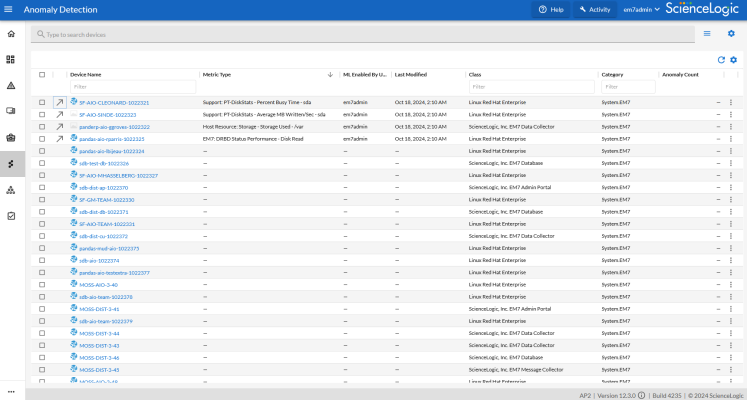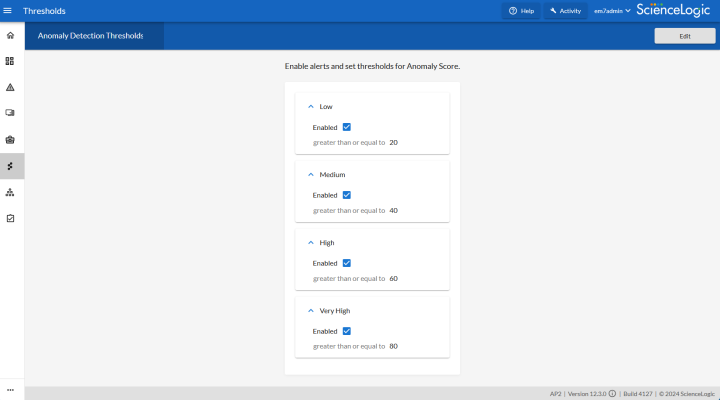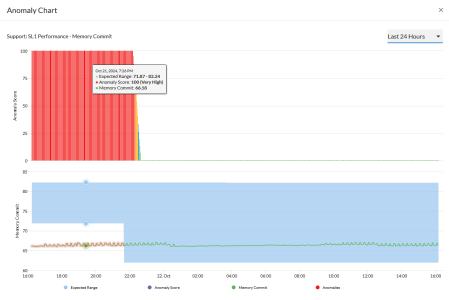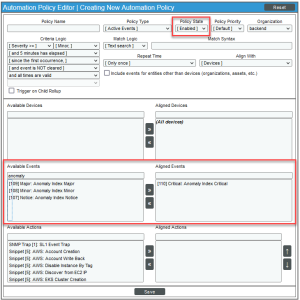The Anomaly Detection component of Skylar Analytics uses Skylar AI to identify unusual patterns that do not conform to expected behavior. Anomaly Detection provides always-on, unsupervised, machine-learning-based monitoring that automatically identifies unusual patterns in the real-time performance metrics and resource data that it observes. Anomalies do not necessarily represent problems or events to be concerned about; rather, they represent anomalous behavior that might require further investigation.
You can view device anomalies for each Dynamic Application metric on the tab on the Device Investigator page for each device. Anomaly Detection also computes an Anomaly Score that characterizes the significance of each anomaly.
Anomaly Detection with Skylar Analytics works with all of the Performance Dynamic Applications in all Skylar One PowerPacks.
What is Anomaly Detection?
Anomaly detection is a technique that uses machine learning to identify unusual patterns that do not conform to expected behavior. Anomaly detection provides always-on, unsupervised machine learning-based monitoring that automatically identifies unusual patterns in the real-time performance metrics and resource data that it observes.
Anomalies do not necessarily represent problems or events to be concerned about; rather, they represent unexpected behavior that might require further investigation.
Anomaly detection is calculated and displayed in the Skylar One user interface for all Dynamic Application metrics. This detection is enabled by default and cannot be disabled.
You can control which device data gets sent to Skylar for analysis based on the organization aligned with the device or devices. All devices in the selected organization will get anomaly detection analysis.
Skylar Analytics starts generating anomaly detection charts and alerts about six to eight hours after data starts getting exported from Skylar One to Skylar AI.
You can view a list of all devices that are being monitored for anomalies on the Anomaly Detection page in Skylar One (Skylar AI (![]() ) > button):
) > button):
The filtered list will appear blank until an Anomaly Score alert triggers an event.
For each device in the list, the Anomaly Detection page displays the following information:
-
Device Name. Displays the name of the device. Click the hyperlink to go to the tab of the Device Investigator page for that device. Each row on the Anomaly Detection page represents a specific device and metric for that device. As a result, a device might appear in the list multiple times if anomaly detection is enabled for multiple metrics on that device.
- Metric Type. Indicates the metric that Skylar One is evaluating for anomalies on the device.
- ML Enabled By User. Indicates the username of the user that enabled anomaly detection for the device and metric.
- Last Modified. Date the metric was most recentlyuipdated.
- Class. Displays the Device Class for the device.
- Category. Displays the device's Device Category.
- Anomaly Count. Displays the number of anomalies detected by Skylar One.
To filter the list of devices on this page by name, type some or all of a device name in the Search field at the top of the window, based on the device-naming convention you used for your devices.
On the Anomaly Detection page, the Anomaly Count column does not currently display the number of anomalies. Go to the tab on the Device Investigator page for a device to see the correct anomaly count. You can sort the Anomaly Count column to see which anomalies are happening the most often.
How Anomaly Detection Works
Initially, a historic profile for anomaly detecting is based on 24 hours of data. These values include minimum and maximum values, median lag differences, and median absolute deviation of those lag values (capturing the variance of lag values from the median lag value.)
Skylar AI uses these statistics to create bands at prediction time that determine anomalous and non-anomalous behavior.
Skylar AI periodically re-calculates and blends these values with the previously calculated values. In general, if the recent period shows more extreme behavior, then Skylar AI uses these values to update the model. If the recent period is less extreme, then the model statistics will move in the direction of these less extreme values.
At prediction time, the bands also take into consideration recent behavior that was deemed non-anomalous, allowing for gradual trends that go outside the pre-computed bands.
With the final min/max expected values computed, Skylar AI considers anything outside of those values to be anomalous. Skylar AI calculates a score based on the distance outside of the band, normalized by a value based on typical point-by-point changes.
Viewing Graphs and Data for Anomaly Detection
After Skylar One begins performing anomaly detection for a device, you can view graphs and data about each anomaly. Graphs for anomalies appear on the following pages in Skylar One:
- The Skylar OneEvents page, filtered by "Anomaly messages (Skylar AI (
 ) > button for Skylar Anomaly Detection).
) > button for Skylar Anomaly Detection). - The Anomaly Detection page (Skylar AI (
 ) > button).
) > button). - The tab in the Device Investigator.
- The tab in the Service Investigator for a business, IT, or device service.
You can view the anomaly detection graphs for devices by clicking the Open icon (![]() ) in the first column of the table on the inventory page. The Anomaly Chart modal appears, displaying the "Anomaly Score" chart above the chart for the specified metric you are monitoring.
) in the first column of the table on the inventory page. The Anomaly Chart modal appears, displaying the "Anomaly Score" chart above the chart for the specified metric you are monitoring.
The "Anomaly Score" chart displays a graph of values from 0 to 100 that represent how far the real data for a metric diverges from its expected values. The anomaly score indicates the significance of an anomaly, with a greater severity as the number gets bigger. The lines in the chart are color-coded by the severity level of the event that gets triggered as the data diverges further. The score is basically a running sum over a small window of time, so after the anomalies stop, the score will drop to zero over that time.
You can define the thresholds for the "Anomaly Score" chart on the Anomaly Detection Thresholds page (Skylar AI (![]() ) > button). You can also use this page to specify whether the Anomaly Score values generate alerts in Skylar One. For more information, see Enabling Thresholds and Alerts for the Anomaly Chart.
) > button). You can also use this page to specify whether the Anomaly Score values generate alerts in Skylar One. For more information, see Enabling Thresholds and Alerts for the Anomaly Chart.
The second graph displays the following data:
- A blue band representing the range of probable values that Skylar One expected for the device metric.
- A green line representing the actual value for the device metric.
- A red dot indicating anomalies where the actual value appears outside of the expected value range. The number of the red dots are listed in the Anomaly Count column on the tab of the Device Investigator page.
You can hover over a value in one of the charts to see a pop-up box with the Expected Range and the metric value. The Anomaly Score value also displays in the pop-up box, with the severity in parentheses: Normal, Low, Medium, High, or Very High.
You can zoom in on a shorter time frame by clicking and dragging your mouse over the part of the chart representing that time frame, and you can return to the original time span by clicking the button.
Enabling Thresholds and Alerts for the Anomaly Chart
You can define the thresholds for the "Anomaly Score" chart that displays on the Anomaly Chart modal, and whether those values generate alerts in Skylar One, on the Anomaly Detection Thresholds page (Skylar AI (![]() ) > button).
) > button).
You can view the alert levels when you hover over a value in one of the charts on the Anomaly Chart modal. The Anomaly Score severity level displays after the index value, in parentheses: Normal, Low, Medium, High, or Very High:
An Anomaly Score severity level of Normal is assigned to a value in the chart that is lower than the lowest enabled alert level. For example, if the threshold for the Low severity is enabled and set to 20 or higher, an Anomaly Score of 16 would have a severity level of Normal.
To edit the Anomaly Score thresholds:
- On the Anomaly Detection Thresholds page (Skylar AI (
 ) > button), click .
) > button), click . - For each of the four severity levels, from Low to Very High, you can click to check Enabled to have Skylar One generate an alert when the Anomaly Score is equal to or greater than the threshold for that severity level.
- You can edit the threshold value for each level if Skylar One is generating too many (or not enough) anomalies of a certain severity level.
- For example, if you want to enable a Low level alert when the Anomaly Score value is between 25 and 39, you would go to the Low panel, select Enabled, and update the value from "20" to "25".
- Click .
- You can then edit an event policy that uses alerts based on the settings on this page to generate events in Skylar One. For more information, see Creating an Event Policy for Anomalies.
Enabling Anomaly Detection Events for Specific Metrics
While anomaly detection is enabled automatically as soon as you enable Skylar Analytics for one or more Skylar One organizations, you can also set up anomaly detection events for specific Dynamic Application metrics on a device. When this is configured, an event policy is triggered when an anomaly is detected for that metric. Anomaly detection events display with an Event Source of Skylar AI on the Events page in Skylar One.
To enable anomaly detection events for a metric on the Device Investigator page:
-
On the Devices page (
), click the Device Name for the device on which you want to enable anomaly detection events and click the tab on the Device Investigator page.
If the tab does not already appear on the Device Investigator, click the More drop-down menu and select it from the list of tab options.
If your Skylar One system does not have any Dynamic Applications enabled, you will see only dashes (—) listed in the table on the tab for a device.
-
On the tab, click the Actions icon (
 ) for any of the listed devices and select Enable Alerting. You can also select multiple devices using the check box on the left and click the button at the top. The Select Available Metrics modal appears.
) for any of the listed devices and select Enable Alerting. You can also select multiple devices using the check box on the left and click the button at the top. The Select Available Metrics modal appears. -
In the Select Metric drop-down of the Select Available Metrics modal, click the name of the metric on which you want to enable anomaly detection events for the device.
-
For some metrics, a second drop-down field might display that enables you to specify the device directory. If this field appears, click the name of the directory on which you want to enable anomaly detection.
- Click . That metric is enabled for events for that device.
To disable anomaly detection events for a metric, click the Actions icon (![]() ) for that metric and select Disable Alerting.
) for that metric and select Disable Alerting.
Creating an Event Policy for Anomalies
You can create additional event policies that will trigger events in Skylar One when anomalies are detected for those devices.
Because anomalies do not always correspond to problems, ScienceLogic recommends creating an event policy only for scenarios where anomalies appear to be correlated with some other behavior that you cannot otherwise track using an event or alert.
Because the anomaly detection model is constantly being refined as Skylar One collects more data, you might experience a larger number of anomaly-related events if you create an event policy for anomalies soon after enabling anomaly detection compared to if you were to do so after Skylar One has had an opportunity to learn more about the device metric's data patterns.
The Event Policies page in Skylar One was completely updated in version 12.5.1. Use the following procedure if you are on Skylar One 12.5.1 or later, or use the next procedure if you are on an older version of Skylar One.
To create an event policy for anomalies in Skylar One version 12.5.1 or later:
- Go to the Event Policies page (Events > Event Policies) and click the button. The tab of the Event Policy Editor page appears.
- In the Event Policy Name field, type a name for the new event policy.
- Click to select the checkbox for Enable Event Policy.
- In the Event Source field, select Internal.
- Click the button.
- In the Link-Message modal page, search for "Anomaly" to locate the message "Anomaly Detected: %V":
- Select the radio button for the message "Anomaly Detected: %V", and then click .
- Complete the remaining fields and tabs in the Event Policy Editor based on the specific parameters that you want to establish for the event. For more information about the fields and tabs in the Event Policy Editor, see Defining an Event Policy.
- When you are finished entering all of the necessary information into the event policy, click .
To create an event policy for anomalies in versions of Skylar One before 12.5.1:
- Go to the Event Policies page (Events > Event Policies, or Registry > Events > Event Manager in the classic SL1 user interface).
- On the Event Policies page, click the button. The Event Policy Editor page appears.
- In the Policy Name field, type a name for the new event policy.
- Click the tab.
- In the Event Source field, select Internal.
- In the Match Criteria field, click the button.
- In the Link-Message modal page, search for "Anomaly" to locate the message "Anomaly Detected: %V".
- Click the radio button for the message "Anomaly Detected: %V", and then click .
- Complete the remaining fields and tabs in the Event Policy Editor based on the specific parameters that you want to establish for the event. For more information about the fields and tabs in the Event Policy Editor, see Defining an Event Policy.
- To enable the event policy, click the Enable Event Policy toggle so that it is in the "on" position.
- When you are finished entering all of the necessary information into the event policy, click .
Using Anomaly-related Events to Trigger Automated Run Book Actions
Skylar One includes automation features that allow you to define specific event conditions and the actions you want Skylar One to execute when those event conditions are met. You can use these features to trigger automated run book actions whenever an anomaly-related event is generated in Skylar One.
To use anomaly-related events to trigger automated run book actions:
-
Go to the Automation Policy Manager page (Registry > Run Book > Automation).
-
Click the button. The Automation Policy Editor page appears:
- In the Policy State field, select Enabled.
- In the Available Events field, search for and select one or more anomaly-related event policies, and then click the right-arrow icon to move each event to the Aligned Events field. For more information about anomaly-related events, see Creating an Event Policy for Anomalies.
- In the Available Actions field, search for and select one or more run book actions that you want to run when the anomaly event from step 4 occurs. Click the right-arrow icon to move each action to the Aligned Actions field. For example, you might want to send an email or create a ticket for that anomaly event.
- Complete the remaining fields on the Automation Policy Editor page based on the specific parameters that you want to establish for the automation policy. For more information about the fields on the Automation Policy Editor page, see Automation Policies.
- When you are finished, click .




